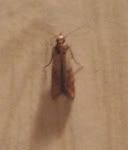365 Urban Species. #006: Indian Meal Moth
Urban Species #006: Indian Meal Moth Plodia interpunctella

An argument could be made that humans would never have developed cities if it weren’t for the agricultural innovation of stored grains. What is indisputable, though, is that many wildlife species have benefited from that innovation. For the Indian meal moth (henceforth referred to as the grain moth), stored grains provide food, habitat for their larvae, and transportation. Grain moths are shipped world-wide in bags of rice, boxes of dried pasta, sacks of pet food and bird seed, and in many other containers of many other grain-based products.
Discovering the colorless maggot-like larva in one’s food-especially after one has eaten several bites of it-is a memorable experience. Extreme larval infestations bind stored grain into distressing webby clumps of caterpillar silk, half-eaten grain, and bug poo. Adult moths flutter about in lazy circles, often in front of the television. Grain moths are thought to be the most common household insect pest in North America. They may have the widest current range of any lepidopteran (moth or butterfly) species.
Please pardon the low-res quality of this photograph. You can see the distinctive copper wing markings in this enlargement, but due to the low light of the setting (my dark kitchen) the resolution is not good. Perhaps I can convince cottonmanifesto to use her considerable macro photography ability to get a better shot of one of these.

An argument could be made that humans would never have developed cities if it weren’t for the agricultural innovation of stored grains. What is indisputable, though, is that many wildlife species have benefited from that innovation. For the Indian meal moth (henceforth referred to as the grain moth), stored grains provide food, habitat for their larvae, and transportation. Grain moths are shipped world-wide in bags of rice, boxes of dried pasta, sacks of pet food and bird seed, and in many other containers of many other grain-based products.
Discovering the colorless maggot-like larva in one’s food-especially after one has eaten several bites of it-is a memorable experience. Extreme larval infestations bind stored grain into distressing webby clumps of caterpillar silk, half-eaten grain, and bug poo. Adult moths flutter about in lazy circles, often in front of the television. Grain moths are thought to be the most common household insect pest in North America. They may have the widest current range of any lepidopteran (moth or butterfly) species.
Please pardon the low-res quality of this photograph. You can see the distinctive copper wing markings in this enlargement, but due to the low light of the setting (my dark kitchen) the resolution is not good. Perhaps I can convince cottonmanifesto to use her considerable macro photography ability to get a better shot of one of these.